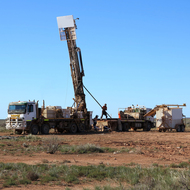WA resources sector gets $10 million a year for the next two years to boost exploration
| Date: | Thursday, 24 August 2017 |
|---|
The State Government today announced its continued support for the Exploration Incentive Scheme (EIS), providing $10 million a year for the next two years through Royalties for Regions funding, from July this year.
The announcement is the successful outcome of a review of the EIS along with all other Royalties for Regions funded programs.
Department of Mines, Industry Regulation and Safety (DMIRS) EIS Coordinator Margaret Ellis said the funding was good news for the WA Resources sector.
“To date the EIS has funded projects which have significantly improved the understanding of WA geology,” she said.
“The main aim of the EIS is to encourage exploration in underexplored greenfields areas by reducing risk to explorers by providing geological information.”
The EIS consists of several programs with about $5 million a year spent on a number of programs, including flagship precompetitive regional geophysics surveys, collaborative research projects, development of cutting edge database and systems, and Regional 3D modelling.
Ms Ellis said the other flagship program of the EIS was the Co-funded Exploration Drilling program.
“Programs, such as the precompetitive geoscience data generated by the EIS and support by the co-funded drilling, provides important geological knowledge which is key to the future development of the State’s resources sector,” she said.
“This highly competitive Co-funded drilling program offers refunds for innovative exploration drilling projects.”
The Co-funded drilling program offers a refund of up to 50 per cent of direct drilling costs through a competitive application process which is open for applications twice a year for projects to be drilled in the following financial or calendar year.
Co-funding offers, which are refunded after completion of the drilling project and supply of data by the successful applicant, are capped at $200,000 for a single deep hole, $150,000 for a multi hole project and $30,000 for applications in the prospectors category.
The reports submitted by the explorers are released via the WAMEX or WAPIMS exploration databases after a short confidentiality period with any core which is submitted from cored drilling projects available in either the Perth or Kalgoorlie core libraries.
“To date the EIS has funded projects which have significantly improved the understanding of WA geology,” Ms Ellis said.
“These include increasing the coverage of WA by high quality medium spaced airborne geophysics to almost 100 per cent, increased gravity coverage of the State to about 50 per cent, as well as a number of regional deep crustal seismic surveys including across the Eucla into South Australia and a line over 700km long along the coastal edge of the Canning Basin.”
Other successful EIS funded projects have included the re-development of the world leading Petroleum exploration database, WAPIMS, redevelopment of the minerals tenement management systems and the Tengraph database, as well as funding a number of internal and Collaborative research projects resulting in over 50 publications available through the GSWA eBookshop.
The Co-funded drilling program has provided co-funding for more than 370 projects undertaking some 560,000 metres of drilling since 2009, which have contributed to more than 25 discoveries, including the Nova-Bollinger Mine which has commenced production and exporting ore.
The modelling in an independent economic impact review of the EIS released in 2015 found that for every $1 million invested in the EIS the long run expected net benefit to the State, in terms of higher GDP, is $23.7 million.
Western Australia’s ranking as a destination of choice for explorers worldwide has improved dramatically to being in the top three in the World in the Fraser Institute Survey of Mining Companies as well as being voted as having the best geological databases.

